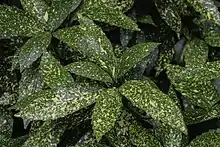Aucuba japonica
Aucuba japonica, commonly called spotted laurel,[2][3] Japanese laurel,[2] Japanese aucuba[2] or gold dust plant (U.S.), is a shrub (1–5 m, 3.3–16.4 ft) native to rich forest soils of moist valleys, thickets, by streams and near shaded moist rocks in China, Korea, and Japan.[1] This is the species of Aucuba commonly seen in gardens - often in variegated form. The leaves are opposite, broad lanceolate, 5–8 cm (2.0–3.1 in) long and 2–5 cm (0.79–1.97 in) wide. Aucuba japonica are dioecious. The flowers are small, 4–8 mm (0.16–0.31 in) diameter, each with four purplish-brown petals; they are produced in clusters of 10-30 in a loose cyme. The fruit is a red drupe approximately 1 cm (0.39 in) in diameter, which is avoided by birds.[4]
| Spotted laurel | |
|---|---|
 | |
| Aucuba japonica | |
| Scientific classification | |
| Kingdom: | Plantae |
| Clade: | Tracheophytes |
| Clade: | Angiosperms |
| Clade: | Eudicots |
| Clade: | Asterids |
| Order: | Garryales |
| Family: | Garryaceae |
| Genus: | Aucuba |
| Species: | A. japonica |
| Binomial name | |
| Aucuba japonica | |
| Synonyms[1] | |
| |
The variegation, considered by some to be an attractive property, is caused by 'Aucuba bacilliform', a putative species of virus in the genus Badnavirus.[5]
Cultivation and uses
Aucuba japonica was introduced into England in 1783 by Philip Miller's pupil John Graeffer, at first as a plant for a heated greenhouse. It became widely cultivated as the "gold plant" by 19th-century gardeners. The plants being grown were female, and it was a purpose of Robert Fortune's botanizing trip to newly opened Japan in 1861 to locate a male. It was located in the garden of Dr. Hall, resident at Yokohama, and sent to the nursery of Standish & Noble at Bagshot, Surrey. The firm's mother plant was fertilized and displayed, covered with red berries, at Kensington in 1864, creating a sensation that climaxed in 1891 with the statement from the Royal Horticultural Society's secretary, the Rev. W. Wilkes, "You can hardly have too much of it".[6] A reaction to its ubiquitous presence set in after World War II.
This plant is valued for its ability to thrive in the most difficult of garden environments, dry shade. It also copes with pollution and salt-laden coastal winds. It is often seen as an informal hedge, but may also be grown indoors as a houseplant.[7] Today numerous cultivars are available from garden centres. The most popular cultivar is 'Variegata', with yellow spots on the leaves;[8] this is a female clone, a similar male clone being named 'Maculata'. The following cultivars have gained the Royal Horticultural Society's Award of Garden Merit:
- 'Crotonifolia'[9]
- 'Golden King'[10]
- 'Rozannie' – A self-fertile variety not requiring a pollinator, produces deep red berries against solid green, glossy foliage.[11]
Other cultivars include:-
- forma longifolia[12]
- 'Mr. Goldstrike' – Male plant with leaves heavily speckled in yellow.[13]
- 'Picturata' – Female plant with yellow foliage fringed with green.[14]
- 'Petite Jade' – Variety with narrower leaves than other species, slender, and serrated. Solid green, growing to 6 ft. tall (can reach 10 ft. after 20 or more years).[15]
Gallery
 Painting by Dutch artist A.J. Wendel, 1868
Painting by Dutch artist A.J. Wendel, 1868 Female clone Variegata
Female clone Variegata Fruits
Fruits Leaves
Leaves
 Male
Male
References
- Kew World Checklist of Selected Plant Families
- "Aucuba japonica". Germplasm Resources Information Network (GRIN). Agricultural Research Service (ARS), United States Department of Agriculture (USDA). Retrieved 8 January 2018.
- English Names for Korean Native Plants (PDF). Pocheon: Korea National Arboretum. 2015. p. 370. ISBN 978-89-97450-98-5. Archived from the original (PDF) on 25 May 2017. Retrieved 26 January 2017 – via Korea Forest Service.
- Fell, Derek (1992). The essential gardener. Gramercy. ISBN 0517693399.
- "Aucuba bacilliform (Aucuba ringspot virus)". Taranaki Educational Resource: Research, Analysis and Information Network. Retrieved 28 January 2020.
- Coats (1964) 1992.
- RHS A-Z encyclopedia of garden plants. United Kingdom: Dorling Kindersley. 2008. p. 1136. ISBN 978-1405332965.
- "...whose measled form is now so common that one hardly realizes that there is also an unspotted Aucuba, which can be quite a handsome bush" (Coats 1992).
- "Aucuba japonica 'Crotonifolia' (f/v) AGM".
- "Aucuba japonica 'Golden King' (m/v) AGM".
- "Aucuba japonica 'Rozannie' (f/m) AGM".
- "Aucuba japonica f. longifolia".
- "Mr. Goldstrike Aucuba". Monrovia.com. Retrieved 2018-02-20.
- "Picturata Aucuba". Monrovia.com. Retrieved 2018-02-20.
- "Petite Jade Aucuba". Monrovia.com. Retrieved 2018-02-20.
External links
| Wikimedia Commons has media related to Aucuba japonica. |